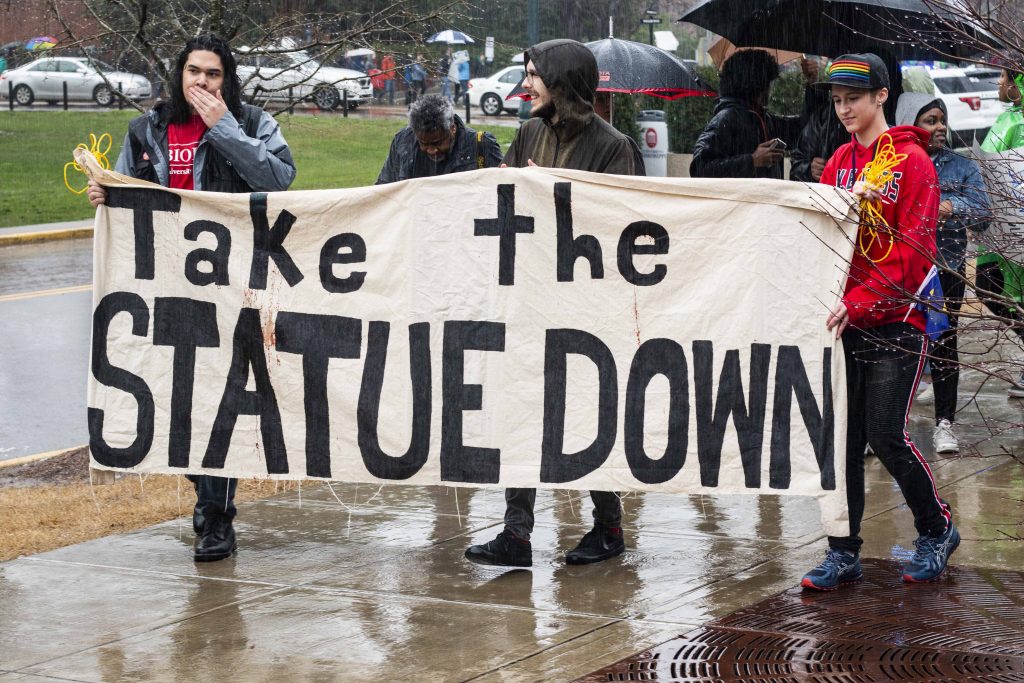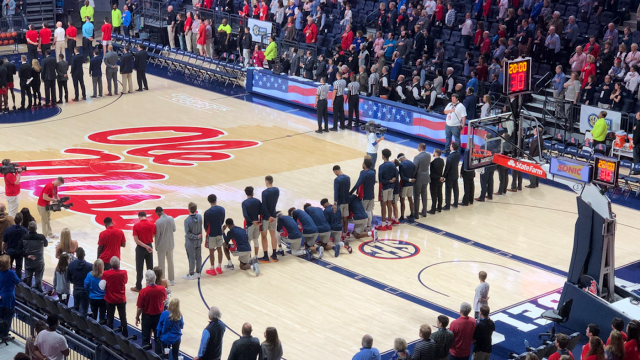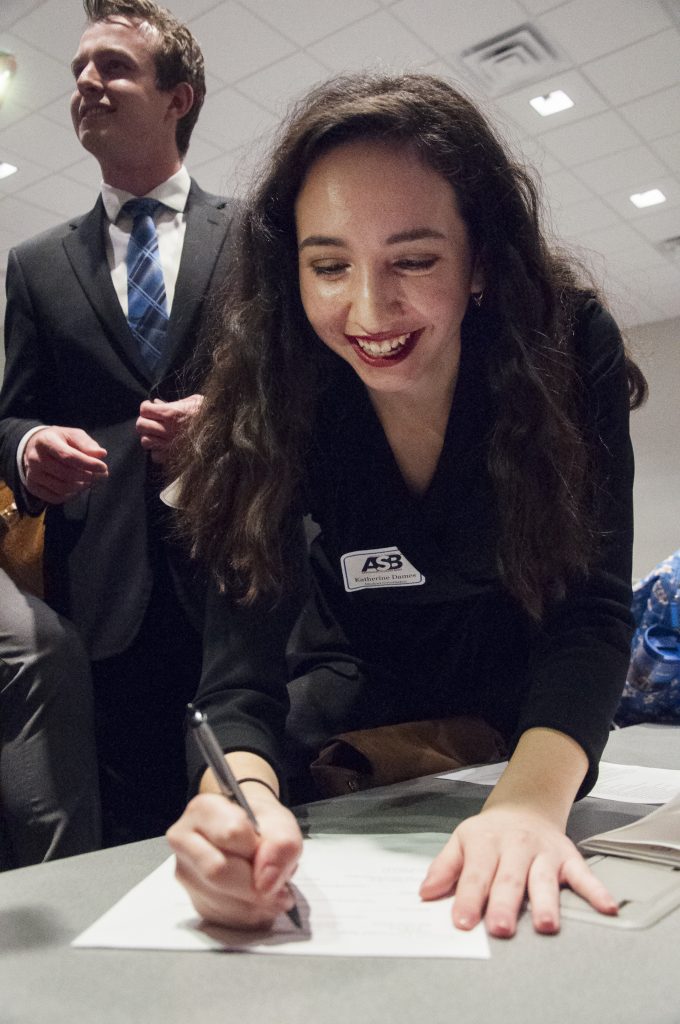It is an undeniable fact of the universe and all of the forces and principles that stitch it together that Newton’s cradle would keep passing energy back and forth, oscillating until the end of the time, if it weren’t for external forces acting upon the steel balls, friction slowing its swaying.
It’s just its nature.
Our campus is no different — in the midst of its daily seas, the flagship university’s tides are forever cresting toward opposite extremes, and this year, its waves have rolled toward change — deeply real, tangible, student-led change.
That’s not to say this change hasn’t been bubbling under the surface for years — it has — but the waves have crested this year, the energy has crescendoed, and this came after a notoriously offensive Facebook post from September that received national attention.
Following former journalism school namesake Ed Meek’s post that singled out two university students for their existence as black women, the university hosted a forum on Sept. 20, 2018, one day after Meek’s post was published.

In the post, Meek called for community leaders to “protect the values that we hold dear that have made Oxford and Ole Miss known nationally,” and attached photos of Mahoghany Jordan and Ki’yona Crawford in bar attire on the Square.
The following night, Nutt Auditorium buzzed with palpable energy as university community members and students definitively spoke out in support of the women and in support of change on campus.
The packed room was at times so quiet that the walls echoed with the silence and gravity of the unsaid words and at times so loud with affirmations and murmurs of the audience that whoever had the microphone could not be heard.
“I didn’t read that Ole Miss has a crime problem,” sophomore Seyna Clark said at the forum, referring to the language of Meek’s post. “I read that Ole Miss has a black problem.”
Since that night, conversations have shifted and gained a sort of urgency that former Daily Mississippian and Ole Miss Yearbook editor-in-chief Alex McDaniel, a 2010 graduate, said she has never seen before on the Ole Miss campus.

“Especially as somebody who was directly involved with a lot of similar movements years ago that were just in their beginnings, it’s amazing to see the fruition of that 10 years later,” she said. “I think this year has been the culmination.”
Katrina Caldwell, who joined university administration in 2017 as the first vice chancellor for diversity and community engagement, thinks it’s too early to draw conclusions from past events.
“I’m sure as we look back next year and in future years, we are able to reflect on the experiences of this year because it could have been things that happened five years ago that planted the seed,” she said.
McDaniel thinks we’re witnessing those seeds sprout this year. She said that national momentum has added to the newfound sense of urgency on campus in a time where “there is a lot of division in this country.”

“If the Ed Meek thing had happened 10 years ago, I don’t think he would have been out. I really don’t,” she said. “I could be wrong, and that’s not me saying (former chancellor) Dan Jones wouldn’t have done anything about it. I just think it wouldn’t have happened the way it happened.”
When asked, Jones declined to comment on contemporary campus issues.
McDaniel said the university’s push to relocate the Confederate statue on the Circle to the Confederate cemetery on campus was something she thought she was never going to see in her lifetime.
“It seems like students and faculty and a strong alumni base are coming together to push the university forward in a way that isn’t just symbolic because it’s not just about the statue and it’s not about a name on a building,” she said.
Allen Coon, a 2018 UM Hall of Fame inductee, also propelled social change during his time on campus and said that he sees more urgency behind the movement to relocate the statue this year.
“For some reason, it seemed like (the movement) had a lot more strength, like there was a lot more possibility for it, which is surprising because, frankly, I didn’t think that something like this would happen within the next five or 10 years,” he said.

However, Coon said he doesn’t necessarily think that pressure to relocate the statue was dependent upon a counter presence.
“We were just ready,” he said.
Makala McNeil, a 2019 UM Hall of Fame inductee who graduated in December, advocated for change while on campus, spearheading the 2016 “Occupy the Lyceum” protest and the movement to take down the state flag, which culminated in the flag’s removal in 2015.
“While I do support symbolic change — it reshapes the culture of university — I hope students will organize around structural issues that prevail at the university,” McNeil said.
Outgoing Black Student Union president and senior Jarvis Benson was a part of the effort to relocate the Confederate statue; he helped draft the resolution that was passed by the Associated Student Body Senate weeks ago. Benson feels that, during his time at the university, students have broken “away from complacency.”
“It opens the conversation for more systemic, long-term issues to be discussed,” Benson said. “At the base of these conversations lie many issues that affect campus day to day.”
Benson called McNeil’s and Coon’s work on the state flag movement influential but said that in the years after, most students “were not speaking up.”
“This year, I think the Ed Meek conversation really made a spark. I think it opened a door for a lot of important conversations to be had on campus. What’s inspiring is that these conversations are not over,” Benson said. “I know this momentum will continue.”
Outgoing ASB President Elam Miller said that, in his four years at the university, he hasn’t seen campus groups working together toward compromise to the degree that they have been recently. Miller said he’s been most inspired by student engagement in the past few months.
“There is momentum and students on campus wanting to push for positive change. I think that’s a growing group for sure,” he said. “It’s a group that I hope continues to grow.”
Benson spoke to the power of student organizing, specifically on this campus.
“Activism and organizing is in the bloodline of this university,” he said. “I hope that (students) will continue to (organize) in a productive way. While it is inevitable, activism is exhausting. Noes are exhausting. Administration is exhausting. I hope they find fuel from this year to keep the spark alive.”
Donald Cole, former assistant provost and longtime member of the university community, doesn’t necessarily think that the Ed Meek incident was a “spark,” but he thinks it certainly held some “weight.” Cole protested for civil rights as a student in the late ‘60s and called student protests “the most powerful movement a campus can have.”
“I’ve seen (students) become more active … in a very positive way,” he said. “It’s positive in the sense of making sure that the University of Mississippi is not left behind and is a leader amongst other institutions. That has caused a tremendous change over the last few years.”
However, Cole said that the urgency of recent campus movements to shed Confederate symbolism has made those who oppose those movements uncomfortable.
“Not that (the university) wouldn’t have moved there eventually anyway, but the ‘time’ factor was probably the uncomfortable thing for them because students only have a short time here at the university, and to make an impact, they have to make it fairly quick,” he said.
Cole, who worked at the university for more than 25 years in many roles as a mathematics professor, dean of the Graduate School, and later, assistant provost, has seen the university evolve since he was admitted as a freshman in 1968.
“Our campus is kind of like a pendulum that swings one way and another way,” Cole said. “Over the years, I’ve seen our campus change quite a bit and seen it change for the better.”
Though, in actuality, the pendulum ceases to sway and Newton’s cradle eventually comes to a halt, in theory, the steel balls continually trade places from one side to the other, passing energy and momentum back and forth.
This past month, the student body lost the opportunity for the university to elect only its second black woman as ASB president in the school’s history when Leah Davis lost the election. When the Mississippi sun rises and sets, light sprays out of the technicolor Tiffany stained glass window in Ventress Hall that freezes the University Greys in the gory glory of the Civil War battlefield. For now, the Confederate soldier still stands guard at the helm of campus, looming over the heads of passersby.
The futures of some of these symbols are uncertain, and the university is anything but predictable, but it is hard to deny something has changed on campus this year. It can be heard in the halls of the Lyceum, seen in the Grove on game days and felt in the hearts of those who cross campus each day. Physics tells us that all things can come to a shuddering stop when opposing external forces act upon them, so it’s expected the university might follow suit, but for now — at least this year — the momentum continues.






